It’s getting to be what I call “harrier time” here in northern Utah so I thought I’d do a significant post on the species. For me, watching these birds hunt is absolutely mesmerizing and I could do it for hours. And I have – many, many times.
But before I get into hunting I’d like to cover some basics on telling the sexes and ages apart. Sexual dimorphism in harriers is exceptional among birds of prey – telling adult males from adult females is easy because their colors are so dramatically different. But because juveniles of either sex strongly resemble adult females, that distinction becomes very tricky and causes a lot of confusion. So, here’s a primer:
- Adult males – gray above, mostly white below, black wing tips, lemon-yellow eyes
- Adult females – brown above, buffy with brown streaks below, lemon-yellow eyes (but in my experience, the eyes of adult females tend to be less bright than those of adult males)
- Juvenile of both sexes – similar to adult female but darker chocolate-brown above and strongly rufous (reddish) below
- Juvenile male – pale, greenish-yellow eyes
- Juvenile female – dark, chocolate-brown eyes
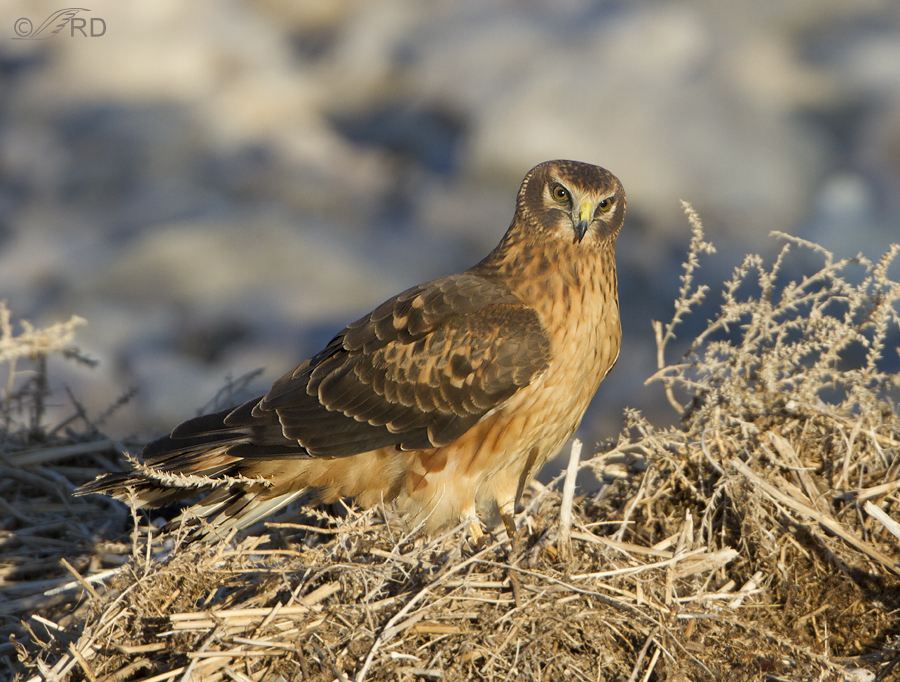
All sexes and ages have the unique facial disc (ruff) characteristic of harriers. It’s not as prominent as it is in many owls but it can clearly be seen in this image. Its function is the same as it is in owls – to direct sound to the ears. Most hawks hunt almost exclusively by sight but because of their excellent hearing, thanks largely to the facial disc, harriers depend at least as much on sound to locate their prey as they do on sight. In fact, they can detect prey by sound alone, with no visual cues.
This bird is a juvenile (rufous below) male (eye color).
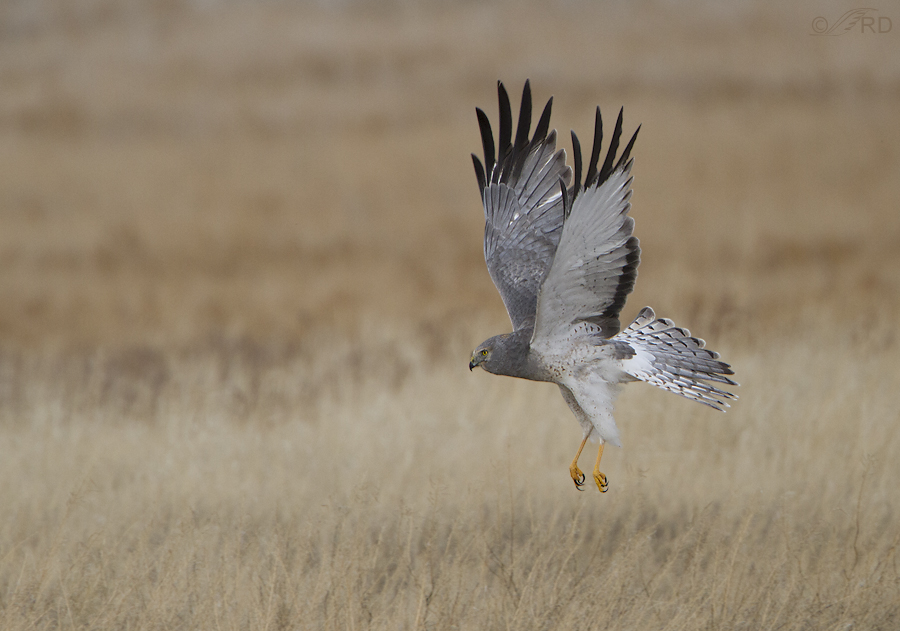
So, this is the adult male – the striking “Gray Ghost, as he’s so often called, hunting. Interestingly, males and females tend to hunt in differing habitats – males preferring more open habitats while females more often hunt in areas with denser, taller vegetation. There seems to be three reasons for this distinction:
- males hunt small birds more than females do
- females have smaller home ranges than males and for much of the year their range is close to the nest (the nest is usually in dense vegetation)
- females vigorously and aggressively exclude males from their hunting habitats during winter
Side note: This little behavioral quirk is something bird photographers should keep in the back of their minds. For many, the adult male harrier is an extremely elusive photographic quarry, so if the male is what you’re after it might be prudent to concentrate your efforts on habitats where the male is more likely to be hunting – more open, with short vegetation that is less dense, as in the photo above
.
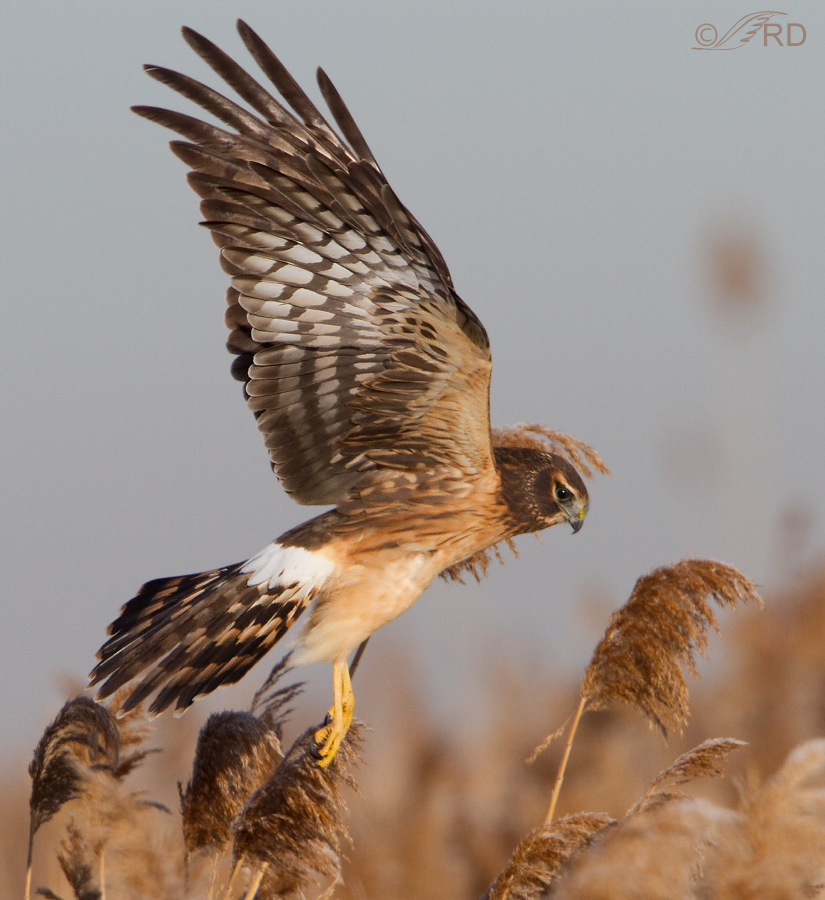
Females hunt habitats like this tall, dense stand of Phragmites more often than do males. These plants are often over 6′ tall and grow quite close together. This bird is a juvenile female (rufous breast and chocolate-brown eyes).
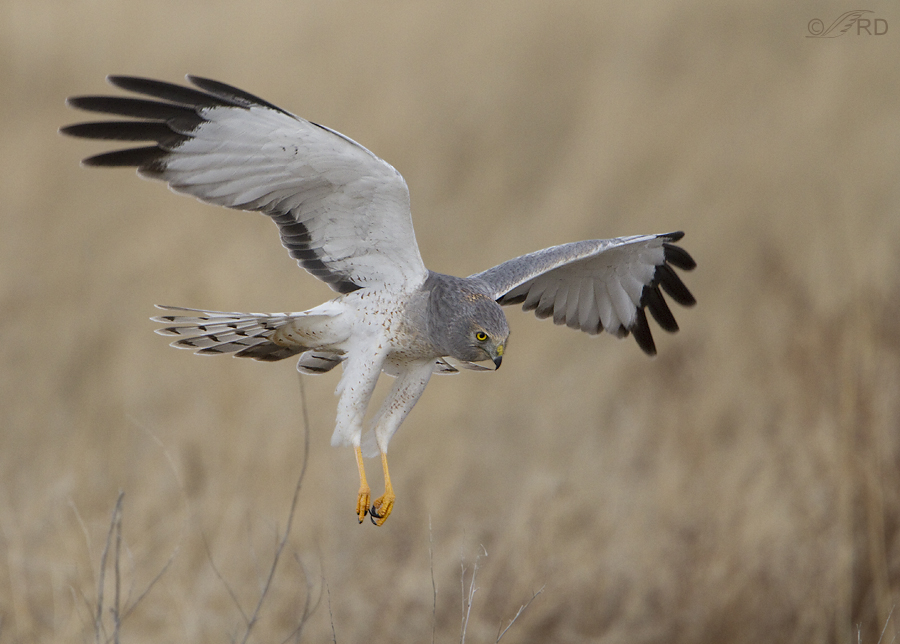
When harriers are hunting they typically fly low and buoyantly over the ground or vegetation. They look and listen very carefully and often their flight speed is quite slow, so to stay aloft at those times they do more flapping than gliding and they typically have their tail spread and their legs hanging down.
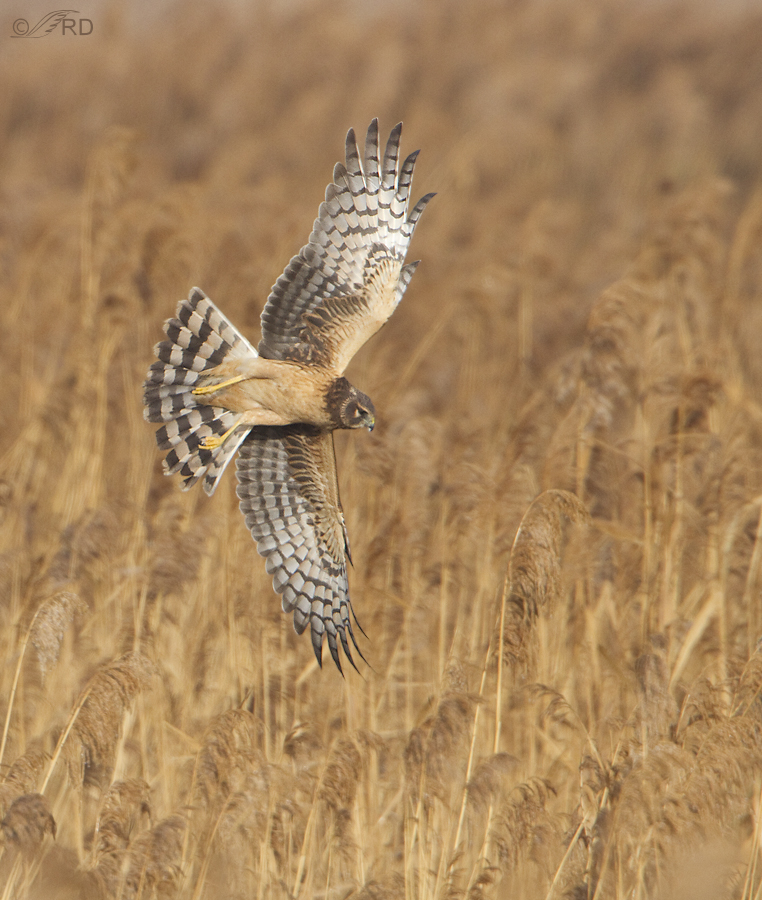
But when they locate prey (usually a vole), which is only several feet below them as they’re flying by, their reaction must be lightening quick before the prey, which has most likely seen them too, escapes down its hole or tunnel. It’s a blast to watch these birds turn on a dime in a microsecond as they dive down after the prey.
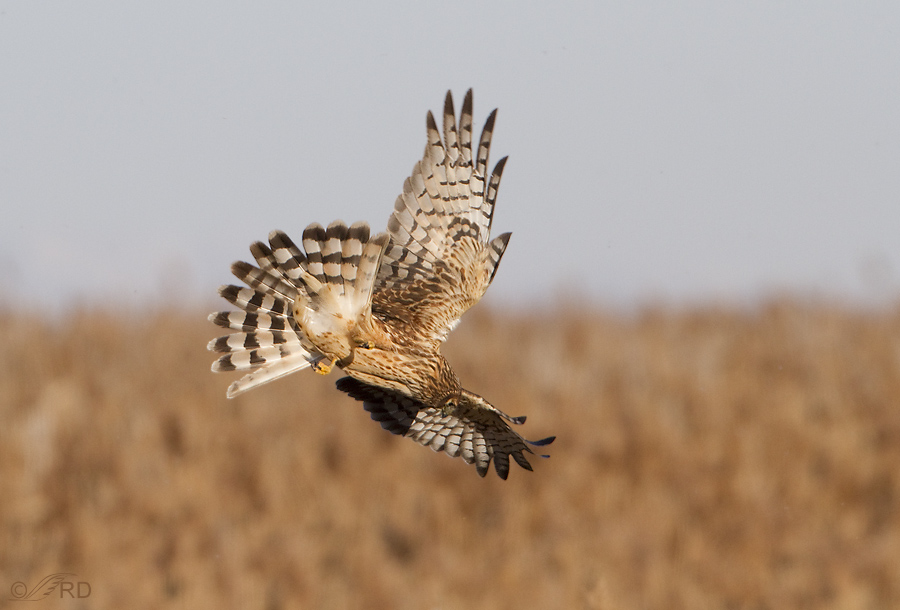
Often their posture as they twist for the dive is so convoluted and twisted as to be almost comical. And it all happens so fast !
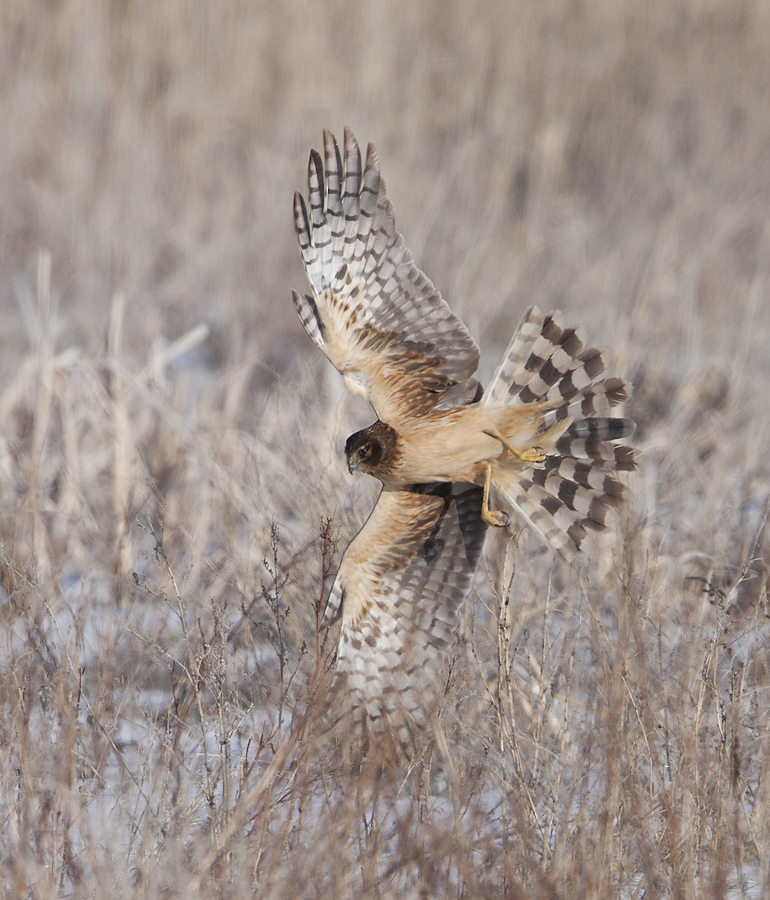
This harrier was so close to the ground when it spotted (or heard) prey that its right wing tip hit the snowy ground as it maneuvered for the pounce.
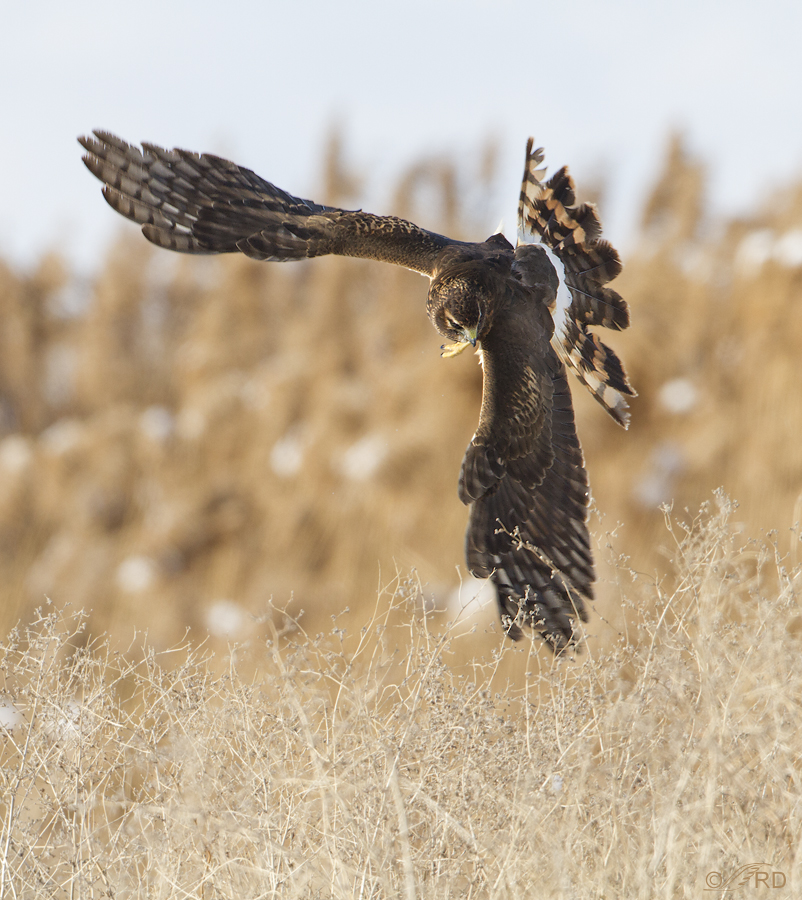
This female detected prey at the base of these thick, 4′ tall “weeds” as she passed by. She quickly turned in the air to pounce but couldn’t get through the weeds, though she was very persistent in trying for perhaps a full minute.

Twice she actually dove head first into the mass of stems, trying to get through the plants to the probable vole on the ground (it could have been a small bird using the thickness of the weeds for cover). But after all that effort she came up empty-taloned and eventually flew off to try her luck elsewhere.
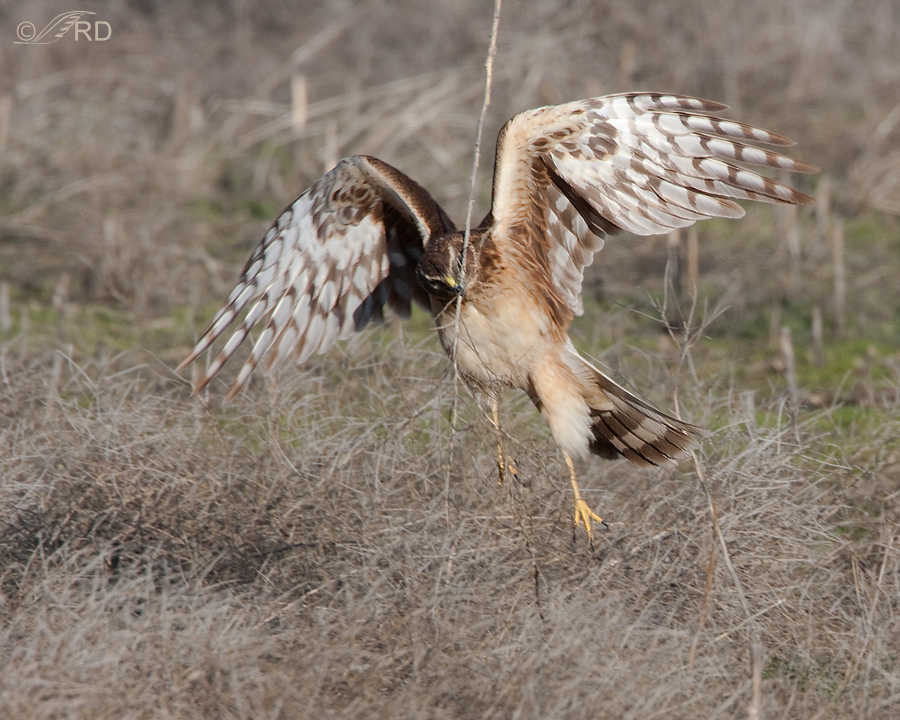
I was amazed by the behavior I saw from this juvenile female. As she flew over these previously snow-packed, very dense weeds she obviously heard a vole down there. But she couldn’t get to it. She landed on top a few times, cocked her head as she pinpointed the direction of the sound she was hearing, and repeatedly pounced but failed at catching the vole. Then she actually started clearing the brush away.
Here, she’s grabbed one of the twigs, lifted into the air a few inches with it and deposited it to her left. She did this several times.

Then she reached down through the twigs to grab this half buried and wet, partly rotted piece of wood (I didn’t even know it was there), lifted it into the air and dropped about a foot away. I suspect it was an entire nest of voles she was after because she certainly was willing to invest a lot of effort in getting to it.
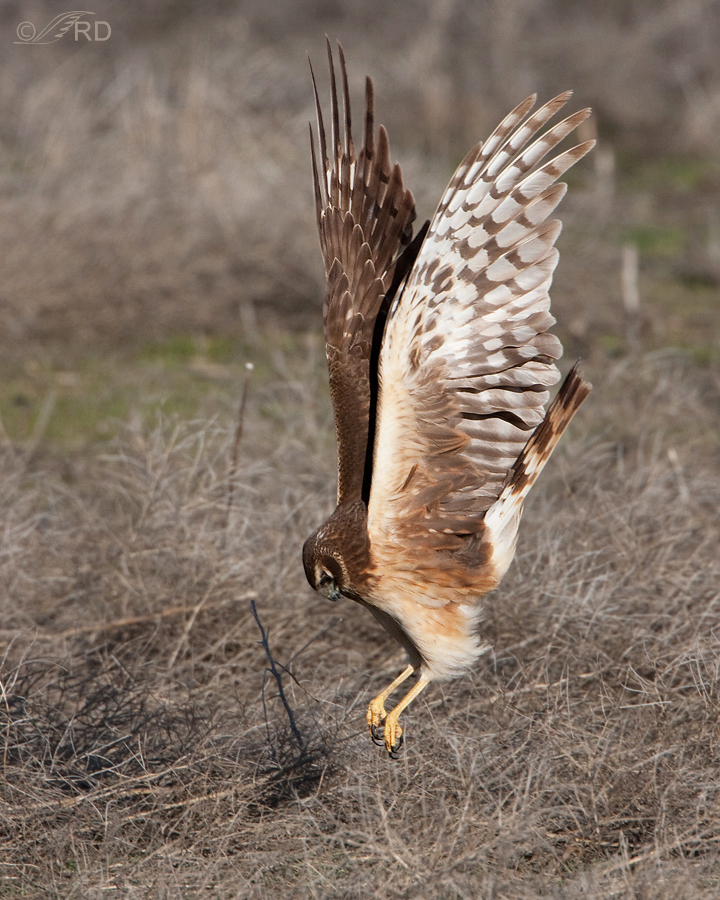
Then she, once again, repeatedly pounced on the spot. I’m sorry to report that she never did come up with any voles.
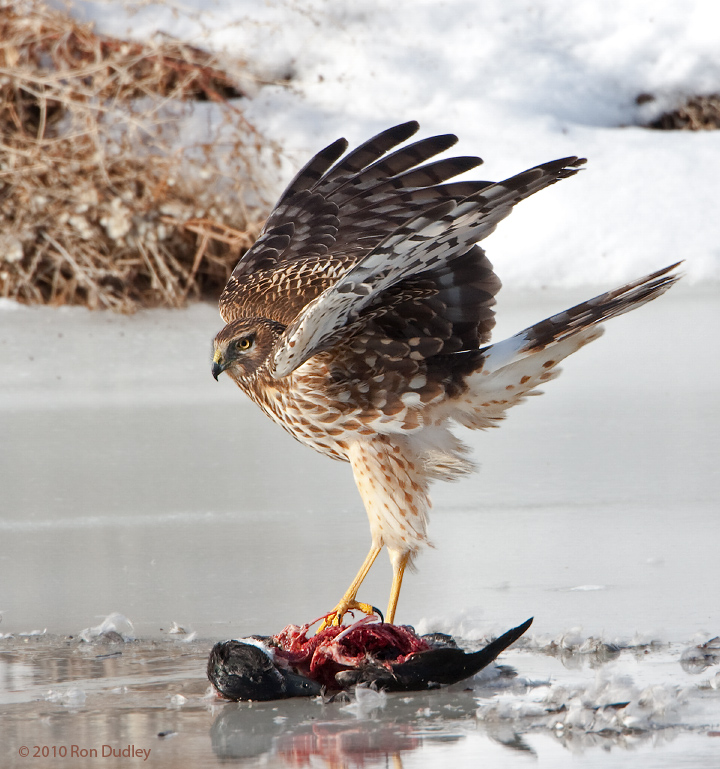
Scavenging is also a type of “hunting” that harriers rely on, especially in winter. Severe conditions produce dead bodies and most of them are a potential meal for a hungry harrier. This bird has just landed on a duck carcass frozen into the ice.
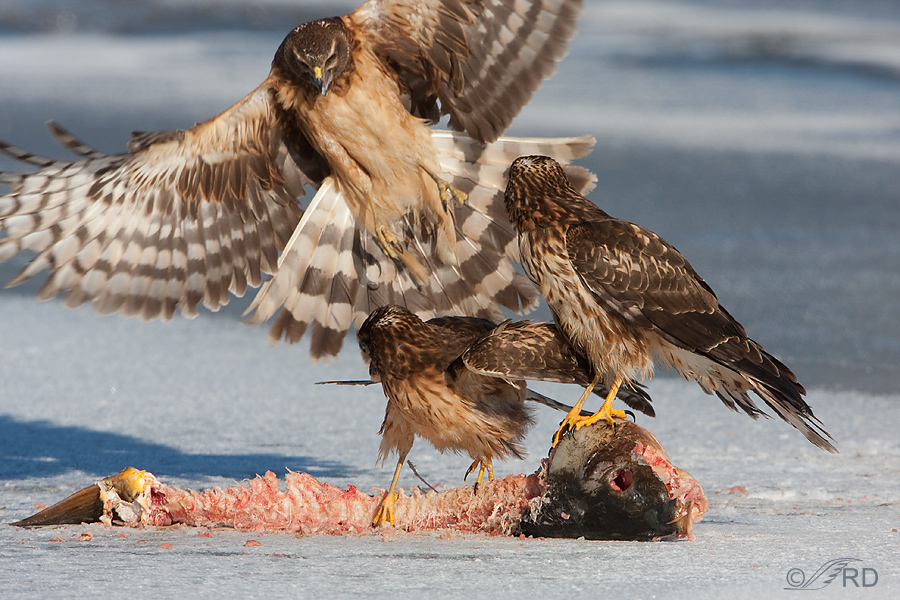
They also scavenge fish, like this carp on the ice that has been fed upon for hours by multiple harriers. Aggressive interactions and food stealing become commonplace during cold winters when food is at a premium. Often, the fighting is fierce.
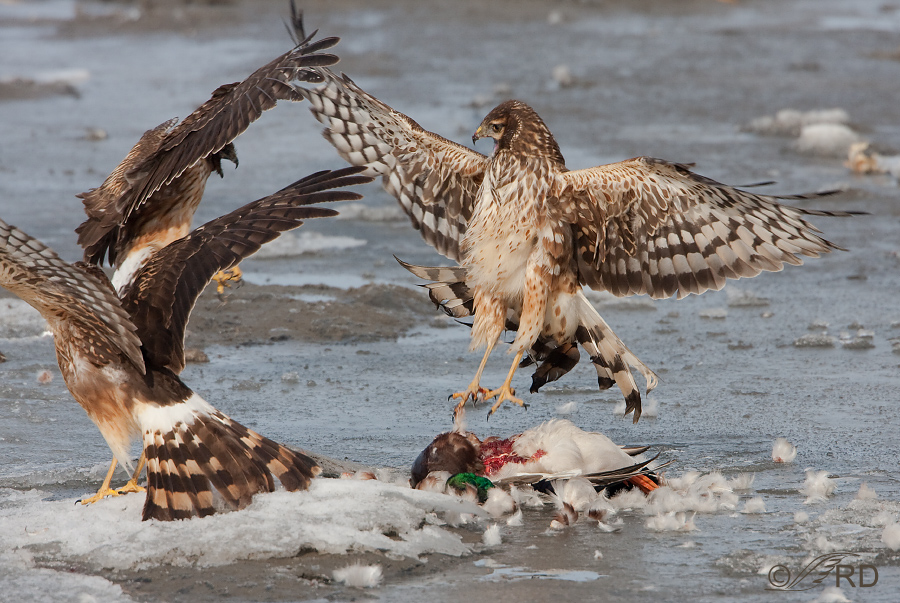
Multiple harriers compete for a Mallard frozen into the ice.
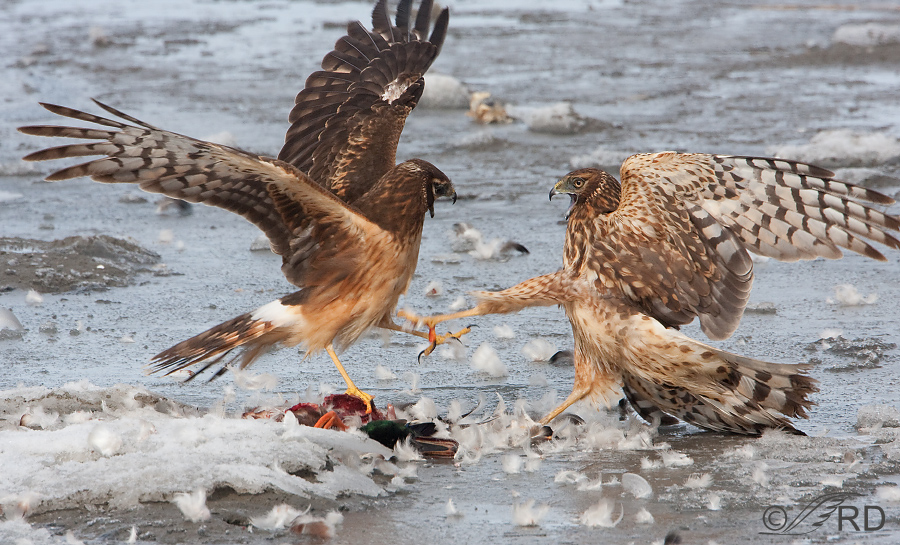
I clipped some wings here, but as you can see the action was fast and furious.
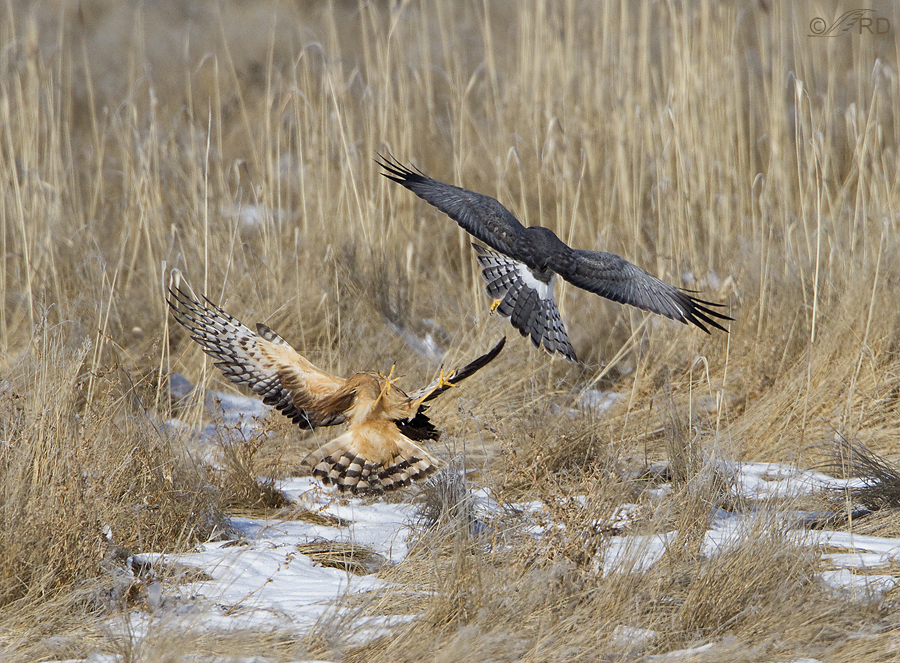
Occasionally, when one harrier is on the ground and surrounded by relatively high vegetation, another one will come along while hunting and neither one will be aware of the other’s presence until the very last second. When they see each other, it’s a surprise for both of them and they react instinctively. Females average 50% heavier than males and they win virtually all aggressive interactions between the sexes so normally males avoid seriously tangling with them when they can.
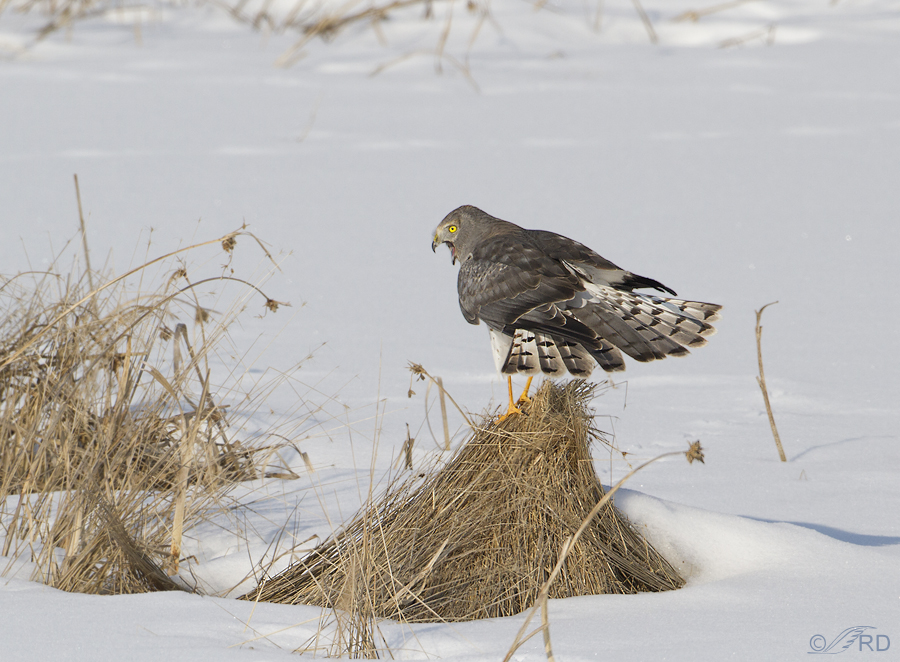
Harriers aren’t happy campers when another harrier invades their hunting territory. This male is screaming and displaying to another male flying into the area.
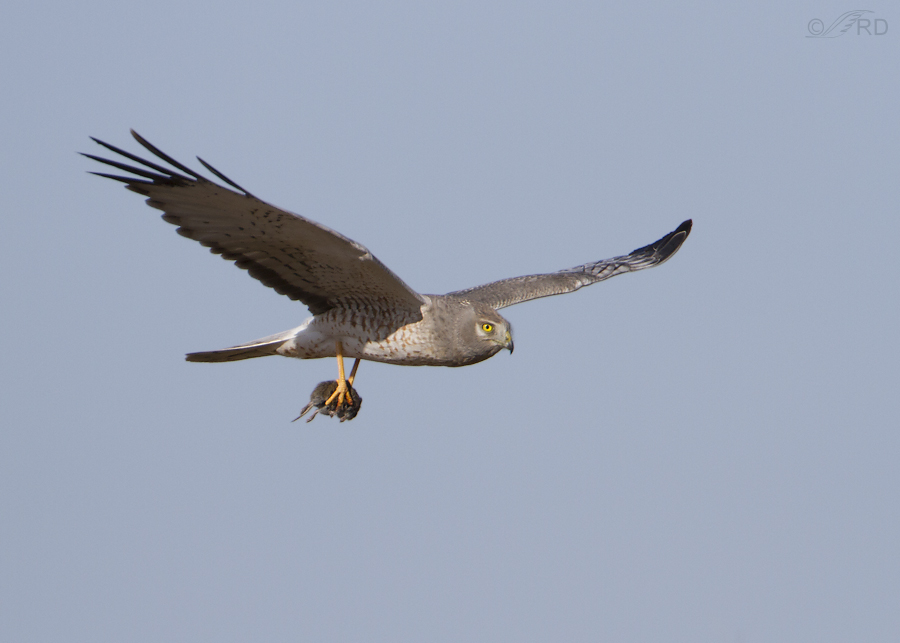
In my experience, harriers normally eat their meal on the ground where it was caught. But this image was taken in May, so I suspect this male is delivering the meal to the nest. This is one of the few flight shots I have of a harrier with prey.
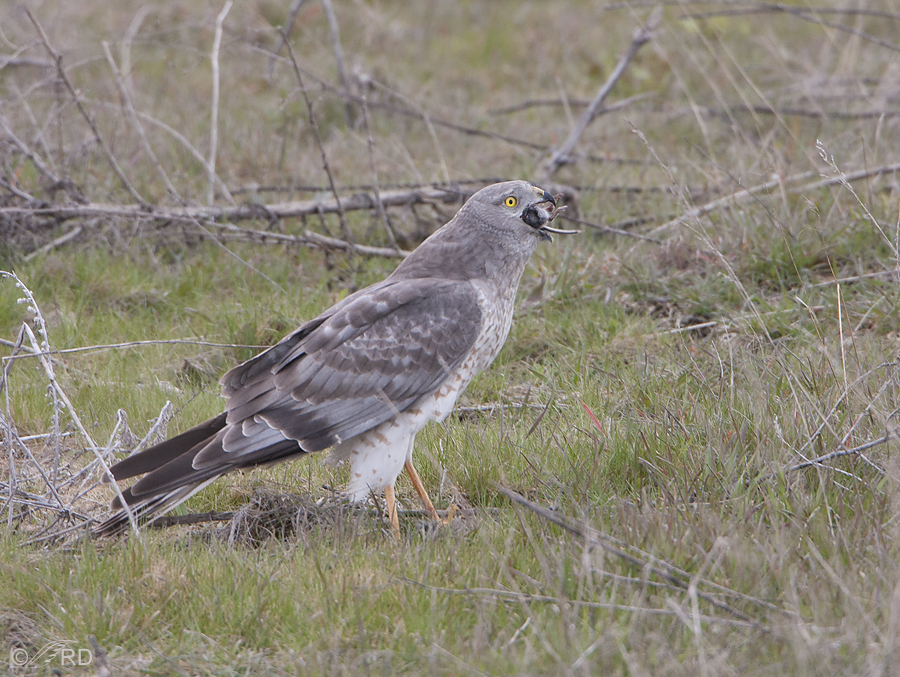
Well, this is what it’s all about, isn’t it? Finally, a meal. Calories! A salve for that gnawing in the stomach. Harriers sometimes eat their voles piecemeal, sometimes only eviscerate them first and other times swallow them whole. This male decided to go for the gusto.
I adore harriers. They get me through the winter…
Ron
Notes:
- I’ve used Birds of North America Online as a source for some of the natural history information I’ve presented here.
- I’ve posted a few of these images previously
- I do not bait. But it should be noted that the fish (carp) in one of these images was one that had been killed by humans at a refuge as a means of controlling the damage they do to submergent vegetation needed for waterfowl
- Occasionally I still struggle with telling the difference between juvenile males and females and adult females, especially when the juvies are in transition. If I’ve made any errors here, please point them out


Ron your work is outstanding I had the chance to go out with a friend and shot these beautiful bird ,they did not disappoint us
Beautiful photography and good information!
Thanks for the excellent posting.
How wonderful! Thanks for sharing!
Ron, what’s most spectacular about posts like this is how you and Mia manage to capture natural behavior and predation without the use of artifice or lures. I don’t think the average person viewing wildlife shots is aware of the tactics some wildlife photographers use to acquire their “natural” images. I respect you so much for your method, your ethics, and then for the talent and skill involved in getting those shots according to your personal values. Thank you. You’re a beautiful emissary for photography and for wildlife. And you’re a great teacher to works-in-progress like myself.
Ingrid, what you’ve said here means a lot to me. Thank you. I just know what works for me. I like to think of myself as a “nature” photographer and if I were to us setups or bait it just wouldn’t be natural and I might as well shoot in a zoo. Besides, as we both know, baiting very often has significant negative effects on birds. To be perfectly honest, I wish baiting of raptors (and using decoys) were illegal…
Thank you for a really significant post! The images are simply breath taking. What a beautiful raptor!
Thanks a lot, Wally.
Well, that is just TOO cool. I didn’t know that re: where males v. females forage. What a delightful, beautiful, and interesting post. Thanks!! =)
Thank you very much, Biobabbler.
Amazing! You have outdone yourself this time with this engrossing story and images of one of my favorite birds. I, too, love to watch them hunt, they spend a lot of time in our neighborhood in Teasdale. However, this year has been scarce for most raptors. Thank you!
That’s the second time you’ve mentioned the scarcity of raptors around Teasdale, Tana. I wonder what’s going on down there – perhaps a crash in the vole population?
Again an great post and great photos. I am sooooo jealous. I see the Norther Harriers quite often, but nearly 100% of the time from a distance, and usually only solitary ones.
Thanks, Bob. Most often they’re solitary around here, too.
Your photos of all these magnificent birds will help me get through the winter. Thanks so much especially for the descriptions of the harriers .
Well, that’s two of us who will make it till spring! Thanks, Diana.
And I loved this post – all of it. Thank you. I am fascinated by the different plumage the harriers have depending on their age and/or sex. I suspect only another of the same type of bird can reliably tell some of ours apart. A white cockatoo is a white cockatoo…
I’ll bet you do have some tricky ones down there in Australia, Elephant’s Child. The amount of sexual dimorphism in Northern Harriers is pretty much unique in North American raptors.